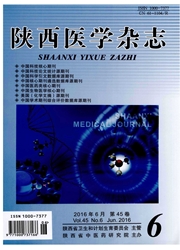

 中文摘要:
中文摘要:
目的 探讨中期因子及CTGF与糖尿病肾病患者纤维化相关因子关系.方法选择糖尿病患者104例,根据是否合并糖尿病肾病分为单纯糖尿病组(A组)、糖尿病肾病组(B组)、糖尿病肾病合并肾衰竭组(C组),分别有41例、35例、28例,分别对各组MK、CTGF、PI NP、PⅢNP进行检测.结果B组患者MK、CTGF水平较A组均出现显著性升高(P〈0.05),C组患者较A、B组MK、CTGF均出现显著性升高(P〈0.05).B组患者PI NP、PⅢNP较A组均出现显著性升高(P〈0.05),C组患者PI NP、PⅢNP及PI NP/PⅢNP较A组及B组均出现显著性升高(P〈0.05).MK与PI NP、PⅢNP显著正相关(P〈0.05),与PI NP/PⅢNP未见显著相关性(P〉0.05),CTGF与PI NP、PⅢNP、PI NP/PⅢNP显著正相关(P〈0.05).结论 MK、CTGF水平升高与糖尿病肾病患者纤维化相关因子密切相关,对其水平检测有助于明确糖尿病肾病纤维化的进展.
 英文摘要:
英文摘要:
Objective To investigate the relationship of midkine and CTGF to diabetic nephropathy associated fibrosis factors. Methods 104 diabetic patients were divided into DM group (A, 41 cases) , diabetic nephropathy group (B, 35 eases), diabetic nephropathy with renal failure group (C, 28 cases) according to whether they were complicated with diabetes, respectively. MK, CTGF, PI NP and PIlI NP were detected. Results The levels ofMK, CTGF, PI NP and Pill NP of patients in group B were significantly higher than those in group A (P 〈 0.05) . The levels of MK, CTGF, PI NP and PⅢ NP of patients in group C were significantly increased compared with those in groups A and B (P 〈 0.05) . MK was significantly positively correlated with PⅠ NP and P Ⅲ NP (P 〈 0.05) , while had no significant correlation with PI NP/P Ⅲ NP (P 〉 0.05) . CTGF was significantly positively correlated with PI NP, Pill NP and PI NP/PⅢ NP (P〈 0.05) . Conclusion MK and CTGF were closely associated with fibrosis-related factors in patients with diabetic nephropathy, and their levels detection will help to monitor fibrosis progression of diabetic nephropathy.
 同期刊论文项目
同期刊论文项目
 同项目期刊论文
同项目期刊论文
 期刊信息
期刊信息
